 I called this piece 3-In-1 done in 1994, a fake Joseph Kosuth. Actually it was a restaging of the Kosuth piece that put the three separate elements (photo, chair, Photostat) into a frame making it into a single discreet art object. The original piece by Kosuth titled, One In Three Chairs has three separate parts. It was done in 1965.
I called this piece 3-In-1 done in 1994, a fake Joseph Kosuth. Actually it was a restaging of the Kosuth piece that put the three separate elements (photo, chair, Photostat) into a frame making it into a single discreet art object. The original piece by Kosuth titled, One In Three Chairs has three separate parts. It was done in 1965.
3-in-1 is part of a larger project called Faux Conceptual Art. It deals with the meta-language of art and it’s reproduced image. This is especially poignant when dealing with Conceptual Art. Conceptual Arts’ main vehicle for presentation was the photograph. Somehow, the notion of a documentary photo was a stand-in or a record of an event occurring. In the case of Conceptual Art, there would often be a set of circumstances or a location or a performance that was ephemeral or temporary. The only way to convey a partial sense was to document the event. This would happen through the use of text or video or the photograph. The text was sometime a script, sometimes a proposal sometimes a menu or schedule of events or sometimes a poetic internal discourse or monolog or sometimes a set of instructions. In any case the position of the photograph or recording device was used to capture something.
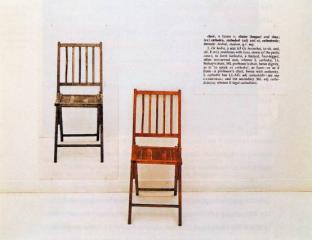 One in three chairs, 1965, Joseph Kosuth
One in three chairs, 1965, Joseph Kosuth
Harking back to the Walter Benjamin essay,Art In the Age of Mechanical Reproduction, Benjamin talks about the “aura” of an art work. His premise is that a unique artwork loses its aura if it is mechanically reproduced. I have no idea what Benjamin meant by an aura. It’s a sort of spiritualist word but the idea that there is something more to art than just the object is conveyed by this notion in Benjamin. Conceptual Art especially in its documentation seems to point to that other something that is not necessarily the object; there’s a linguistic component of the sign or signifier and the signified. This becomes a bit tricky when looking at a photographic documentation of a conceptual art work. Is the photograph the sign, signifier or signified? Since photography has a sense of neutral point of view, objective as opposed to subjective, it is assumed to truthful in its presentation. The art then supposedly happens outside the photograph. The problem is that the sort of photo/text presentation of most Conceptual Art creates it’s own signified, to whit, one is looking at a work of conceptual art. This was proposed by Robert Smithson, an earthworks artist, in his notion of site/non-site where the gallery can function as a non-site or presentation of information such as documentation and yet can also be a site for art.
The idea of a site for information is a rather timely idea. Often in deconstructionist critique the surround elements and the external siting of any work within a society effectively “contextualizes” it. The idea of documentary objects as stand-ins for real objects or events give the document an authority as a primary source even though it is not the prime object. This is the basis for all media. The picture carries as much weight/identity/truth as the actual object or event. The picture also has the potential for mass duplication. The site of the information is the media. This is where the copyright advocates get up in arms. They insist that the ownership of the original also entails its’ ownership across all media and its’ infinite duplication in the digital networks. Indeed the notion of a site for information that correlates physical location with information is a hallmark of Internet design and structure. All of the language of information networks is equated to movement and travel. Indeed, when one surfs the internet one has the sense of going someplace to get information even as there is no movement other than a changing of screenic images. In this transformed information landscape objects and ideas can have several meaning and states of being. They can be originals or copies of signs or pointers to locations.
Cultural signifiers such as artworks or films or books or TV shows or newspapers function in myriad different ways. They reinforce the culture that produces them. They make a tribal statement that says; this is our identity, this is who we are. They also function as a historical record. With the advent of a global media sphere, where all information is accessible via the networks local signifiers also function globally. This is also true of historical signifiers. Indeed, what was once dependant on a specific time and place to have meaning is no longer the case. A recent bit of oral whit , a meme if you will has been making the round of the information class. People are saying, “There is no there, there. “ I would extend that to say, “There is no now, now. 
Getting back to the One In Three Chairs and the 3-In-1 re-make. There is a Western culture subtext to these works. It is the Christian debate about One God in three forms (Father, Son, Holy Spirit). Another cultural archetype that I play with and is apparent in both is the Tarot Card of the Magus (alchemist, magician). It is also the sign of the artist. Its’ description is, “Spirit penetrating matter and informing it.”
On the linguistic level, the original Kosuth work is a straightforward presentation of chair as an object, a word, and an image. There is however several aspects that tie it to the style Conceptual Art. It is done as an installation piece rather than a single object. It is didactic in its’ presentation but it leaves out the original thesis which is the idea of how language evolve from speech to writing. There is no audiotape of someone saying chair. I have never seen this piece in person. I have only seen reproductions in books and magazines.
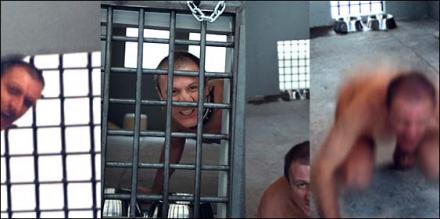
This brings up another issue that some artists are addressing in their work. They are trying to get to the original feeling of the piece by re-staging it. They are also doing simulations of work they have only seen in reproductions. These art works are re-presented in a different context at a different time. They are “re-contextualized.” For Example Oleg Kulik, a Russian artist, did a piece that was riffing on, Joseph Beuys piece called, I like America and America Likes Me. Kulik’s work is titled I Bite America and America Bites Me. http://www.artseensoho.com/Art/DEITCH/kulik97/kulikinfo.html
Another media artist who is re-staging media events is Mark Tribe. Mark takes a different position with his Port Huron Project:
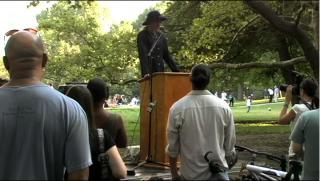 Port Huron Project 1: Until the Last Gun is Silent
Port Huron Project 1: Until the Last Gun is Silent
“The Port Huron Project is a series of reenactments of protest speeches from the 1960s and '70s. Each event takes place at the site of the original speech, and is delivered by an actor to an audience of invited guests and passers-by. Videos based on these reenactments are presented in various venues and distributed online and on DVD as open-source media. The project is inspired by the Port Huron Statement, the visionary 1962 manifesto of Students for a Democratic Society (SDS)*, a student activist organization that played a key role in the American New Left.”
From- http://nothing.org/porthuronproject/
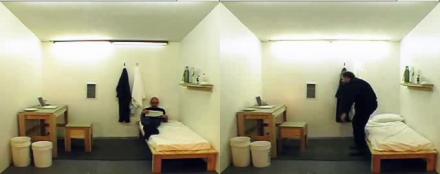 1 Year Performance - still from video
1 Year Performance - still from video
And MTAA , a two-man art team, is doing a series of updates of conceptual and performance art works to fit within the digital and networked realm. http://www.mteww.com/update/
Another notable series of "do-overs" is by Paul McCarthy and Mike Kelley, who did a whole series of Video-Performance “updates” titled Fresh Acconci;
http://www.eai.org/eai/tape.jsp?itemID=1179
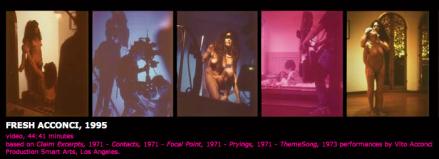 Fresh Acconci
Fresh Acconci
What is apparent is that none of these artists are doing exact copies of the works they are referencing. They are however playing with the signature style and brand names in varying degrees. The discussion is not however a blatant crowbar tactic of prying out and smashing property rights. It is an understanding that intellectual property has different degrees of meaning and use. While Tribes’ Port Huron project seems to be a desire to get at the emotional heart of a signifier, Kulik’s re-staging of the Beuys work is an escalation. In Kulik’s piece the animal and the human combine. MTAA seems to be researching the banal in Conceptual Art, updating it and presenting it on the networks as a pointer to the earlier works and yet the meaning is lost in a language game. Paul McCarthy and Mike Kelley are doing what can only be called remixing by taking Acconci and porno and mixing them together.
One of the unspoken critiques implicit in all these works including my own is the view of the market and the marketing spectacle of commodity capitalism. It is understood that the market only wants variations on styles that are proven sellers. Originality and creativity are the provenance of those who control the market. For Tribe I believe he is looking at the use of the (media) spectacle through a Situationist lens, although it is only a starting point for an investigation of the current plasticity of media. Indeed, Guy Debords’1967 treatise, The Society of the Spectacle, is worth reflecting on. Here’s an excerpt;
“… The spectacle divides the world into two parts, one of which is held up as a self-representation to the world, and is superior to the world. The spectacle is simply the common language that bridges this division. Spectators are linked only by a one-way relationship to the very center that maintains their isolation from one another. The spectacle thus unites what is separate, but it unites it only in its separateness.” –29 Society of the Spectacle.
The least interesting aspect to the analysis of recent mimetic strategies by media artists is to focus on the idea of a copy of an original and intellectual property. Indeed on has only to recognize that artist first impulse is to mimic nature. If nature in late capitalism is the spectacle and the commodities that are in circulation than mimesis of the spectacle is the natural starting point.
http://nujus.net/~gh
http://nujus.net/~nujus/gh_04/fauxCon/index.html